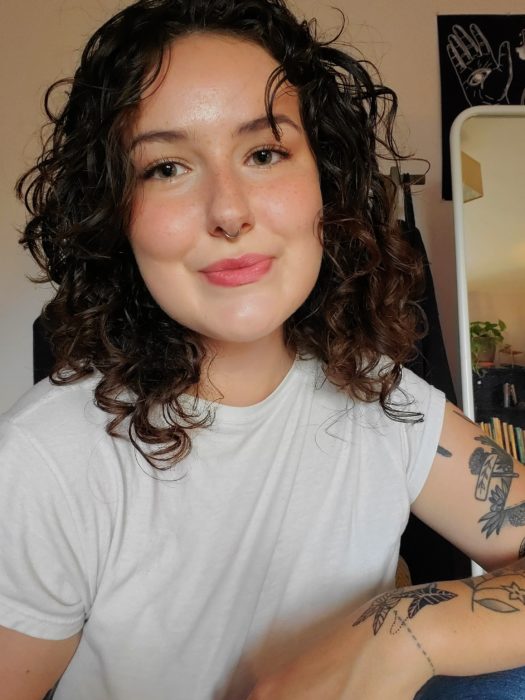Flora May’s Response to “Njiknam (My Younger Brother)”
On Alex’s Instagram feed, a screen-printed image of her brother Matt is carefully framed between the wooden rings of an embroidery hoop. In the photograph, the harsh winter sun seems to bleach his plaid work shirt. In the gallery, the fabric transmits a hint of sunlight where Antle has stitched a row of metallic beads on the head of her brother’s axe.
In Njiknam (My Younger Brother), Antle reveals her search for an embodied appreciation of her relationship to history, family, and their Indigenous connections to the land now called Newfoundland. Reflected in the mixed-media nature of the artworks, we understand culture as the sum of various experiences – for Antle and kin, this includes the cultural heritages of Newfoundland and of the Mi’kmaq.
Beads and caribou hair are placed with an instinctive care to locate the pieces of the Antles’ story which have always been there: the Chaga, the Labrador Tea, the spirit of fire, the iron in a sharp blade. These moments of hand-crafting capture the interconnectedness between tradition and futurism; the artist stitching her brother’s inclusion into the tapestry of their culture.
It is this subtle approach to storytelling that pulls the viewer into the siblings’ world. At times, it is a scraggly fir tree across the water that is embellished; rocks strewn around near a boil-up, which the viewer begins to recognize is full of meaning.
Antle’s work in Njiknam stands proudly with other artists working to share decolonial love – a kinship that is rooted in Indigeneity, solidarity, and liberation. Métis artist Dylan Miner coined the phrase “methodologies of visiting”: acknowledging the work of being present on the land, visiting your folks, to listen and to just be. Miner’s methodology of visiting is a reaction to the diasporic experiences of many Indigenous peoples as a symptom of urbanization, settler colonialism, and the “necessities of wage labour.” This Indigenous way of knowing asserts that the experience of visiting itself becomes a feature of the works. In the moments before and during the artwork is created, the bond is revealed – the art is about the ride in the car, the stop for coffee on the highway (knowing each other’s orders), packing the fishing kit, Alex carefully placing beads attuned to the spirit of the land.
For an artist looking to “challenge the stereotype of what cultural practice looks like,” Alex Antle has successfully activated her unique experiences of siblinghood and Indigeneity to create her own methodologies. Njiknam (My Younger Brother) is a storybook of the siblings’ time spent together, maintaining their relationship to the land and each other, and so, asserting Indigenous sovereignty.
 Flora May is an Inuk artist and educator residing in Toronto, Ontario. She received her Diploma in Textile Arts from College of the North Atlantic (St. John’s, Newfoundland) and is currently pursuing her Honours Bachelor of Craft and Design Furniture at Sheridan College. Her work is informed by skills learned at home in NunatuKavut territory, Labrador. Flora leads youth programming ranging from sewing to watercolour and aims to produce work while promising safe and accessible spaces for Indigenous youth to create and enjoy art.
Flora May is an Inuk artist and educator residing in Toronto, Ontario. She received her Diploma in Textile Arts from College of the North Atlantic (St. John’s, Newfoundland) and is currently pursuing her Honours Bachelor of Craft and Design Furniture at Sheridan College. Her work is informed by skills learned at home in NunatuKavut territory, Labrador. Flora leads youth programming ranging from sewing to watercolour and aims to produce work while promising safe and accessible spaces for Indigenous youth to create and enjoy art.